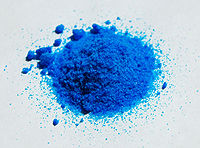硝酸铜
| 硝酸铜 | |
|---|---|

| |

| |
| IUPAC名 Copper(II) nitrate | |
| 别名 | 硝酸铜(II) |
| 识别 | |
| CAS号 | 3251-23-8 10031-43-3(三水) 13478-38-1(六水) 19004-19-4(2.5水) |
| PubChem | 18616 |
| ChemSpider | 17582 |
| SMILES |
|
| InChI |
|
| InChIKey | XTVVROIMIGLXTD-UHFFFAOYAG |
| ChEBI | 78036 |
| RTECS | GL7875000 |
| 性质 | |
| 化学式 | Cu(NO3)2 |
| 摩尔质量 | (无水) 187.57 g/mol (三水) 241.60 g/mol (2.5水) 232.59 g·mol⁻¹ |
| 外观 | 蓝色晶体 |
| 密度 | 2.32 g/cm3 (三水) |
| 熔点 | 114.5 °C (三水) 210 °C 升华 (无水) |
| 沸点 | 170 °C 分解 |
| 溶解性(水) | 138 g/100 mL (0 °C) (三水) |
| 危险性 | |
| 警示术语 | R:R22, R36/37/38, R48/20/21/22, R66 |
| MSDS | Cu(NO3)2.3H2O |
| 主要危害 | 无毒,刺激性 |
| NFPA 704 | |
| 相关物质 | |
| 相关化学品 | 硫酸铜,氯化铜 |
| 若非注明,所有数据均出自标准状态(25 ℃,100 kPa)下。 | |
硝酸铜是铜(II)的硝酸盐,化学式为Cu(NO3)2。无水物和水合物都是蓝色晶体,但性质有很大不同。水合硝酸铜常用于在学校中演示原电池反应。
性质
水合硝酸铜与无水硝酸铜性质有很大差异。
无水物
亮蓝色的无水硝酸铜(Cu(NO3)2)是一种易挥发的固体,在真空中升华。气态时,Cu(NO3)2单体为平面正方结构,每个Cu原子与四个氧原子相连,冷凝时则发生聚合。[1]
  |
水合物
含2.5个结晶水的Cu(NO3)2(H2O)2.5中,中心铜被水分子和硝酸根包围,为八面体配位。[1]
可通过热分解硝酸铜并将产生的气体导入水中来制取硝酸。该方法与奥斯瓦法最后一步类似。
- 2Cu(NO3)2 → 2CuO + 4NO2 + O2
- 3NO2 + H2O → 2HNO3 + NO
浸过硝酸铜的薄木条在火焰下发出翡翠绿色的光,加入硝酸镁则会产生橙绿色。
合成
含水的Cu(NO3)2加热会水解生成碱式盐,进一步加热分解为氧化铜,因此无法通过加热水合物来制取无水硝酸铜。
- Cu + 2N2O4 → Cu(NO3)2 + 2NO
硝酸铜也可由铜与硝酸银溶液发生置换反应得到。
有机合成中的应用
硝酸铜与乙酸酐的混合物(Menke condition)以发现的荷兰化学家命名,是有机合成中有用的硝化剂,用于芳香化合物的硝化。[4]
硝酸铜承载到黏土(蒙脱土)上后,称为粘土铜试剂(Claycop),可用于氧化硫醇至二硫化物,转化缩硫醛为羰基化合物,[5]以及硝化芳香化合物,[6]从而避免大量使用混酸造成的环境污染。
参考资料
- ^ 1.0 1.1 Wells, A.F. Structural Inorganic Chemistry, Oxford: Clarendon Press (1984). ISBN 0-19-855370-6.
- ^ Greenwood, N. N.; Earnshaw, A. (1997). Chemistry of the Elements, 2nd Edition, Oxford:Butterworth-Heinemann. ISBN 0-7506-3365-4.
- ^ Jolly, W. L. "The Synthesis and Characterization of Inorganic Compounds" Prentice Hall, London, 1970
- ^ Menke J.B. Nitration with nitrates. Recueil des Travaux Chimiques des Payes-Bas. 1925, 44: 141.
- ^ Balogh, M. "Copper(II) Nitrate–K10 Bentonite Clay" in Encyclopedia of Reagents for Organic Synthesis (Ed: L. Paquette) 2004, J. Wiley & Sons, New York. DOI: 10.1002/047084289.
- ^ Collet, C.; Delville, A.; Laszlo, P. “Clays Direct Aromatic Nitration” Angewandte Chemie International Edition in English, 2003, Volume 29, Issue 5 , Pages 535 - 536. DOI 10.1002/anie.199005351.
外部链接
| ||||||||||||||||||||||||||||||||||||
Text is available under the CC BY-SA 4.0 license; additional terms may apply.
Images, videos and audio are available under their respective licenses.

